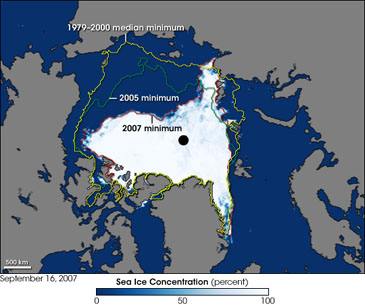Since satellite monitoring began in 1979, sea ice in the Arctic has been on the decline, shrinking by about 10 to 12 percent per decade. In the summer of 2007, Arctic sea ice cover shrank to an unprecedented low. At this rate, researchers project that the Arctic may experience a summer completely devoid of ice by the end of the century.
 An image showing satellite measurements of the minimum Arctic sea ice extent in 2007. For comparison, colored lines show the minimum for 2005 and median minimum for 1979-2000. Credit: NASA Earth Observatory
An image showing satellite measurements of the minimum Arctic sea ice extent in 2007. For comparison, colored lines show the minimum for 2005 and median minimum for 1979-2000. Credit: NASA Earth ObservatorySnow and ice reflect sunlight and help to keep polar sea temperatures cool, but with less of the sea covered by ice and snow, the ocean absorbs more heat from the sun — raising the water temperature and making it even harder for ice to form.
Shrinking ice masses disrupt the life cycles of Arctic animals like seals, walruses, polar bears and seabirds, which depend on ice for places to travel, hunt, and raise young. But a warming Arctic affects the rest of the globe, too. Melting ice means rising sea levels, which can lead to storm surges, flooding and erosion, disrupting delicate coastal ecosystems as well as human communities. A cold Arctic also is essential for the system of wind and ocean currents that regulates Earth’s climate.
Computer models suggest that, if Arctic warming is curbed, sea ice can recover in the future. That leaves it up to humans to keep climate change in check.


